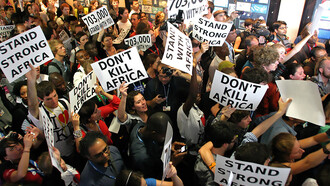Once upon a time, humanitarianism wore no flag. It arrived after the bombers left, with hands raised and heads bowed. It built hospitals where regimes built prisons. It fed the hungry while everyone else was negotiating oil contracts. The NGO worker was the last archetype of moral purity we allowed ourselves to believe in.
Now, not even that illusion remains. Because in the modern warzone, the one holding the syringe often knows the man with the rifle.
They still come in white Land Cruisers, armed with stethoscopes and solar laptops. They still hand out rice, rehydration salts, and leaflets promising resilience. But something has shifted. The slogans are slicker. The donors are larger. And the road of good intentions has never been so stained with human blood.
The grey zone
To understand this shift, you must walk into the grey zone—those contested spaces where NGOs become both a lifeline and a liability. Take Gaza. To get anything in, you coordinate with whoever holds the checkpoints. And for over a decade, that’s been Hamas. You don’t need to wear their colors, but you do need their permission. UNRWA, the UN’s relief agency, knows this better than anyone. Their schools have hosted both traumatized children and hidden rockets. Some staff double as teachers by day and martyrs-in-training by night. A few years ago, even the Secretary-General had to admit that weapons had been found inside UNRWA facilities - before quickly assuring donors that “measures were being taken1”.
However, measures never address the moral foundation.
Islamic Relief Worldwide has faced similar allegations—less overt, more systemic. Despite its carefully cultivated image as a humanitarian bridge between the Muslim world and the West, it has been accused in multiple countries—Israel, the UAE, Germany - of funneling funds into Islamist-linked groups. Of course, nothing sticks long in the world of international aid. A denial here, a compliance audit there, and the caravan moves on2.
Meanwhile, in Yemen and Somalia, the World Food Programme continues to deliver aid by the ton—much of it seized, sold, or “taxed” by militias before it ever reaches a single mouth3. It’s not a failure of logistics; it’s a survival strategy. You want to help? Fine. Just “pay” the gatekeeper, whatever flag he flies.
You can’t hand out water bottles at the gates of Hell without shaking hands with the doorman.
The deeper tragedy is not just that NGOs operate in proximity to terror—it’s that sometimes, they function in concert with it. Not ideologically, but economically.
In Haiti, Oxfam’s misconduct took a darker, more sordid turn: senior staff were found to have hired prostitutes—some allegedly underage - during post-earthquake relief missions, all under the veil of humanitarian work. The scandal, uncovered in 2018, revealed not only abuse of power but also a culture of impunity: whistleblowers were ignored, and key officials quietly resigned before accountability could catch up. Meanwhile, in Iraq and elsewhere, similar patterns of exploitation emerged, suggesting systemic rot rather than isolated lapses4. Yet Oxfam continued to trumpet its values of dignity and justice in glossy reports. After all, as long as the KPIs are met and the donor dashboards stay green, who dares to ask what’s happening off the books?
Then there's USAID—the slick cousin at the diplomatic dinner table. Its public image is all schools and water pumps, but behind the curtain, it has long operated as a geopolitical tool. In Gaza, it has indirectly funded contractors and programs with links to Hamas, not through malice, but through bureaucratic distance5. Layers upon layers of intermediaries. Enough to keep deniability intact. Enough to keep the funding flowing.
The myth of neutrality
Still, the favorite bedtime story remains the same: NGOs are neutral. Apolitical. Pure. The last white flag in a battlefield of black budgets and gray morality. But how can that be true when your logo shows up in war propaganda, when your staff are caught on tape chanting for martyrdom6, or when your funding patterns align perfectly with foreign policy goals?
Neutrality is not a shield; it’s a smokescreen.
UNRWA teaches children about their right of return but sometimes omits Israel from the map. Islamic Relief Worldwide preaches Islamic brotherhood—but overlooks the brothers carrying RPGs just beyond the clinic gates. USAID builds hospitals - but only after negotiating the terms with whoever controls the road, the region, or the narrative.
These are not outliers. They are symptoms of a system that rewards strategic blindness. Where neutrality means: don’t name the oppressor, don’t audit the ally, and don’t ask too many questions in a war zone where morality is measured by quarterly reports and geopolitical necessity.
And we? We call them “non-state actors,” “third-party intermediaries,” and “international civil society.” All very sophisticated ways of saying they do what seems morally right, but they’ve picked a side long before landing their foot in the next third-world, money-laundering hellhole.
Because some NGOs don’t just deliver aid - they deliver legitimacy.
They launder intentions. They translate airstrikes into “stabilization”, mass displacement into “humanitarian corridors”, and drone victims into “beneficiary populations”.
And somewhere between the press release and the press conference, bombs keep falling. But now, they fall with better PR.
The donor’s conscience
Of course, this isn’t about malice. It’s about survival—organizational, financial, and political. Even the most well-meaning NGO is tethered to the invisible leash of donor psychology.
NGOs depend on a delicate ecosystem: suffering must be visible but not too grotesque. Victims must be photogenic but not defiant. Local partners must be efficient but not ideologically messy. Donors must feel righteous but never complicit. The trick is to curate the apocalypse.
So, when a starving Yemeni child becomes the centerpiece of a funding campaign, it’s not always clear who is being saved. The child? Or the conscience of the donor?
The child becomes a brand. His ribs, a marketing metric. Her eyes, a campaign conversion rate. The pain is real, but the packaging is everything.
And what of the locals? The ones who have seen three NGOs leave and four arrive since the last ceasefire? The ones who no longer ask who you are, only how long you’ll be here, and whether you brought medicine or mission statements?
They are caught between a drone strike and a food truck. Between a warlord with a satellite phone and a nutritionist with a clipboard. They do not care which flag your NGO flies. They just want to live. But in the logic of modern humanitarianism, their survival is often secondary to someone else's redemption.
Because in the end, aid isn’t just about helping people. It’s about how helping people makes someone feel about themselves.
The saints that keep the fire burning
And so, the machine turns.
UNRWA continues to operate in Hamas territory with a wink and a shrug. Islamic Relief Worldwide denies everything, issues carefully worded statements, and expands its global footprint. The World Food Programme keeps partnering with whoever owns the checkpoints, filling bellies while occasionally lining pockets.
Everyone stays just clean enough.
In an industry where virtue is monetized, the appearance of goodness becomes more valuable than goodness itself. An uncorrupted mission is useful, but a corrupted mission with clean optics is funding gold.
Bureaucrats who once dreamed of saving lives now spend their days perfecting compliance language. “Due diligence” becomes the holy rite. “Operational context” is the sacred excuse. The spreadsheets are immaculate. The field reports are upbeat. The crisis is ongoing - and that, too, is good for business.
And at the top of the chain, the saints keep the fire burning. They don’t wear halos, but lanyards. They don’t carry crosses, but credentials. They light candles made of quarterly forecasts and pray to the god of institutional relevance.
Because in this world, even angels must fill out grant reports. They must meet deliverables. They must scale impact. And sometimes, the cost of keeping the lights on is pretending you didn’t see the bodies buried behind the clinic.
Sources
1 Govextra. Hamas' use of UNRWA facilities.
2 NGO Monitor. Islamic Relief Worldwide (IRW).
3 Arab News. (2025, April 17). WFP halts food shipments to Houthi-held parts of Yemen after militia seize warehouse.
4 The New Humanitarian. (2021, April 15). Exclusive: Whistleblowers detail new Oxfam misconduct allegations in Iraq.
5 City Journal. How USAID funded Hamas. City Journal.
6 UNRWA. (2024, August 5). Investigation completed: Allegations on UNRWA staff participation in the 7 October attacks.















